
Frontiers of Materials Science
Scope & Guideline
Pioneering Discoveries in Advanced Materials and Applications
Introduction
Aims and Scopes
- Advanced Materials Characterization:
The journal publishes research that employs sophisticated characterization techniques to analyze the properties and performance of materials, including their structural, thermal, and electrical characteristics. - Nanomaterials and Nanotechnology:
A significant focus is placed on nanomaterials, exploring their synthesis, properties, and applications in various fields such as electronics, energy storage, and biomedical engineering. - Materials for Energy Applications:
Research related to materials that enhance energy conversion and storage, such as batteries, supercapacitors, and solar cells, is a core area of interest. - Biomaterials and Tissue Engineering:
The journal includes studies on biomaterials designed for medical applications, particularly in tissue engineering and regenerative medicine, highlighting their interaction with biological systems. - Environmental and Green Materials:
Research on sustainable materials and environmentally friendly technologies, including waste management and pollution reduction strategies, is increasingly emphasized. - Functional Coatings and Surface Engineering:
The development of advanced coatings that impart specific functionalities to materials, such as corrosion resistance, antibacterial properties, and enhanced adhesion, is a key area of publication.
Trending and Emerging
- Smart and Responsive Materials:
There is an increasing focus on materials that exhibit responsive behavior to external stimuli, such as temperature, pH, or light, which can be applied in various fields including biomedical devices and sensors. - Energy Storage Technologies:
Research on advanced materials for energy storage applications, particularly in batteries and supercapacitors, is rapidly expanding, driven by the demand for more efficient energy solutions. - Biomimetic and Bioinspired Materials:
The development of materials inspired by natural systems is gaining traction, particularly in applications related to healthcare and environmental sustainability. - 2D Materials and Heterostructures:
The exploration of two-dimensional materials, such as graphene and transition metal dichalcogenides, along with their heterostructures, is a prominent trend, especially in electronics and optoelectronics. - Additive Manufacturing and 3D Printing:
Research into the application of materials in additive manufacturing processes is on the rise, emphasizing the need for novel materials that can be effectively processed using these technologies. - Nanomedicine and Drug Delivery Systems:
The intersection of nanotechnology and medicine is increasingly significant, with research focusing on the development of nanocarriers for targeted drug delivery and imaging applications.
Declining or Waning
- Traditional Metal Alloys:
Research on conventional metal alloys appears to be declining, as interest shifts towards novel materials and composites that offer superior properties and functionalities. - Basic Polymer Science:
Studies focused solely on the fundamental aspects of polymer science without application to advanced materials or technologies are becoming less frequent. - Conventional Energy Sources:
There is a noticeable decrease in research related to materials for traditional fossil fuel energy applications, as the field moves towards renewable energy solutions. - Classic Ceramics and Glasses:
Research on traditional ceramics and glasses is less prominent, likely due to the rise of advanced ceramics and multifunctional materials that offer enhanced performance. - Simple Composite Materials:
The journal has seen a reduction in the publication of studies on basic composite materials, with a trend towards more complex and application-specific composites gaining traction.
Similar Journals
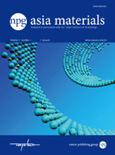
NPG Asia Materials
Connecting Academia and Industry through Cutting-edge ResearchNPG Asia Materials, a premier journal published by NATURE PORTFOLIO, stands at the forefront of research in the fields of condensed matter physics, materials science, and modeling and simulation. With an impressive Impact Factor gracing its Q1 rankings in 2023, this open-access journal, established in 2012, offers a vital platform for disseminating high-quality research articles, reviews, and perspectives that advance the understanding of material properties and innovative applications. Based in the United States and catering to a global audience, NPG Asia Materials features cutting-edge contributions that not only enhance academic scholarship but also provoke discussions relevant to both industry and academia. Researchers, professionals, and students are invited to explore its extensive archive of work, covering insights from 2009 to 2024, in a bid to stay abreast of the latest developments in these rapidly evolving scientific domains.

JOURNAL OF INORGANIC MATERIALS
Advancing the Frontiers of Inorganic ResearchJOURNAL OF INORGANIC MATERIALS, published by SCIENCE PRESS, is a prominent platform dedicated to the dissemination of research in the fields of inorganic chemistry and materials science. With a history spanning over three decades since its inception in 1993, this journal has become a key resource for academics and industry professionals alike, aiming to advance the understanding of inorganic materials through rigorous research findings. It operates under a strict peer-review process, ensuring high-quality contributions that uphold its reputation within the scientific community. Currently ranking in the Q3 category for both inorganic chemistry and miscellaneous materials science, the journal holds a significant position in Scopus rankings, further solidifying its relevance and impact. Researchers will find this journal an essential avenue for the latest discoveries and methodologies in inorganic materials, fostering innovation and collaboration in a vital area of science.
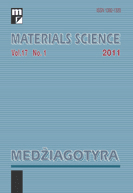
Materials Science-Medziagotyra
Fostering Collaboration in the World of Materials ScienceMaterials Science-Medziagotyra is a prominent peer-reviewed journal dedicated to the field of materials science, published by Kaunas University of Technology in Lithuania. Since its transition to an Open Access model in 2012, it has facilitated broad dissemination of research findings, enhancing accessibility for researchers and professionals worldwide. This journal is indexed in Scopus and has consistently contributed to the academic community with a focus on innovative materials and their applications, ranking in the Q3 category of Materials Science (miscellaneous) as of 2023. With the responsibility of synthesizing substantial research from 2008 through 2024, Materials Science-Medziagotyra aims to bridge gaps in material research while fostering collaboration among scientists, students, and industry leaders. Its commitment to quality and rigor in scientific discourse underscores its relevance and importance in advancing the field.

ADVANCED MATERIALS
Unveiling Breakthroughs in Nanoscience and BeyondAdvanced Materials, published by Wiley-VCH Verlag GmbH, is a premier academic journal that serves as a crucial platform for cutting-edge research in the field of materials science and engineering. With an impressive impact factor and ranking among the top tiers in various categories, including Materials Science, Mechanical Engineering, and Nanoscience, this journal is recognized for its high-quality contributions and relevance to contemporary research challenges. Spanning from 1989 to 2024, Advanced Materials not only features groundbreaking studies but also provides insights into innovative applications and advancements in material design and engineering. Researchers, professionals, and students alike will benefit from the rigorous peer-review process and diverse range of topics covered, making it an indispensable resource for those aiming to stay at the forefront of materials science innovation.

Advanced Materials Interfaces
Exploring the Frontiers of Material InteractionsAdvanced Materials Interfaces is a premier journal dedicated to the exploration and advancement of materials science, with particular emphasis on the interfacial phenomena that govern the behavior of materials in various engineering applications. Published by WILEY in the United Kingdom, this Open Access journal, established in 2014, has quickly ascended to a Q1 category ranking in both Mechanical Engineering and Mechanics of Materials as of 2023, reflecting its significant influence and excellence in the field. With impressive Scopus Ranks, such as #81 out of 672 in Mechanical Engineering and #58 out of 398 in Mechanics of Materials, it serves as a vital resource for researchers and practitioners aiming to push the boundaries of materials innovation. The journal provides unrestricted access to its cutting-edge research, promoting collaboration and dissemination of knowledge among the global scientific community, solidifying its role as a vital contributor to the ever-evolving landscape of materials engineering.
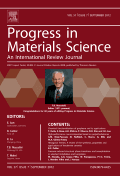
PROGRESS IN MATERIALS SCIENCE
Pioneering Discoveries in Materials SciencePROGRESS IN MATERIALS SCIENCE is an esteemed peer-reviewed journal published by Pergamon-Elsevier Science Ltd, focusing on pioneering advancements and comprehensive studies in the field of Materials Science. With an ISSN of 0079-6425 and an E-ISSN of 1873-2208, this journal boasts a prestigious status, ranking in the Q1 category for Materials Science (miscellaneous) and achieving a remarkable 99th percentile in Scopus rankings, positioned 4th out of 463 journals in General Materials Science. Published from the United Kingdom, PROGRESS IN MATERIALS SCIENCE provides critical insights into the latest discoveries, trends, and methodologies shaping the materials science landscape, making it an invaluable resource for researchers, professionals, and students alike. Readers can explore rich content on subjects ranging from nanomaterials to biomaterials and beyond, all designed to foster innovation and knowledge dissemination in the materials science community. Although it is not an open-access journal, it remains a pivotal platform for high-quality research and essential discourse in this dynamic field.

BULLETIN OF MATERIALS SCIENCE
Fostering Excellence in Material Science ResearchBulletin of Materials Science, published by the Indian Academy of Sciences, is a distinguished journal that has been contributing to the field of materials science since its inception in 1979. With an ISSN of 0250-4707 and E-ISSN 0973-7669, it provides a platform for researchers to share groundbreaking studies and advancements in the mechanics of materials and general materials science. As of 2023, the journal holds a respectable Q3 ranking in both the Materials Science (miscellaneous) and Mechanics of Materials categories, highlighting its competitive position in the academic landscape. Although the journal currently does not operate under an open access model, it remains a vital resource for professionals and students keen on exploring innovative material developments and methodologies. With a commitment to promoting high-quality research, the Bulletin of Materials Science features rigorous peer-review processes, making it an essential reference for anyone engaged in the materials science domain.

ADVANCED FUNCTIONAL MATERIALS
Empowering Researchers with Open Access to Groundbreaking DiscoveriesADVANCED FUNCTIONAL MATERIALS is a leading journal published by WILEY-V C H VERLAG GMBH, prominently recognized in the fields of biomaterials, chemistry, condensed matter physics, and materials science. With an impressive impact factor and a distinguished position in the Q1 quartile across multiple categories including nanoscience and nanotechnology, this journal serves as a vital platform for researchers and professionals committed to innovating in functional materials. Since its inception in 2000, ADVANCED FUNCTIONAL MATERIALS has published high-quality peer-reviewed articles that push the boundaries of materials science, exploring new frontiers in electronic, optical, and magnetic materials. The journal's dedication to open access ensures that its groundbreaking findings are readily available to a global audience, fostering collaboration and knowledge-sharing among scholars and practitioners in the field. For those seeking to stay at the forefront of materials research, ADVANCED FUNCTIONAL MATERIALS is an essential resource.
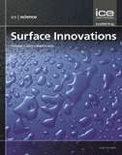
Surface Innovations
Elevating Surface Chemistry to New HeightsSurface Innovations, an esteemed journal published by Emerald Group Publishing Ltd, serves as a crucial platform for researchers and professionals working within the fields of Materials Chemistry, Process Chemistry and Technology, and Surfaces, Coatings and Films. Launched in 2013, this journal has garnered attention for its commitment to advancing knowledge and innovation, holding a distinguished Q3 ranking in multiple categories as of 2023. With a focus on the latest methodologies and applications in surface science, Surface Innovations not only facilitates the dissemination of cutting-edge research but also encourages interdisciplinary collaboration among scientists and engineers. While not an open-access journal, it offers numerous options for accessibility to engage a wide array of audiences, making it a valuable resource for those looking to expand their understanding and expertise in this rapidly evolving field. The journal's consistent inclusion in high-ranking Scopus categories further underscores its academic impact and relevance.
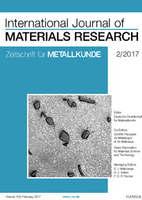
International Journal of Materials Research
Exploring the Future of Condensed Matter PhysicsInternational Journal of Materials Research is a prestigious academic platform specializing in the dissemination of cutting-edge research in the fields of materials science and condensed matter physics. Published by Walter de Gruyter GmbH, this journal serves as a vital resource for researchers, professionals, and students interested in the innovations shaping the materials landscape today. With an impact factor that reflects its growing influence, this journal offers an array of open access options, allowing for broad dissemination and accessibility of published findings. Spanning research from 1994 to 2024, the journal consistently ranks in the Q3 and Q4 quartiles across key subcategories, including materials chemistry, metals and alloys, and physical and theoretical chemistry. By bridging the gap between theoretical frameworks and practical applications, the International Journal of Materials Research provides an essential forum for advancing knowledge and fostering collaborations within the materials research community.